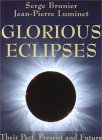
 GLORIOUS ECLIPSES by Serge Brunier and Jean-Pierre Luminet. Cambridge U. Press, Cambridge, UK. 1999-2000. Hardcover. GLORIOUS ECLIPSES by Serge Brunier and Jean-Pierre Luminet. Cambridge U. Press, Cambridge, UK. 1999-2000. Hardcover.
THE SUN NEVER SAYS
Even
After
All this time
The sun never says to the earth,
"You owe me."
Look
What happens
With a love like that,
It lights the
Whole
Sky.
from The Gift by Hafiz, Sufi poet
SONGS OF THE ECLIPSES
The Sun is in love with the Earth
The Earth is in love with the Sun
That concerns them alone
That is their affair
And when there are eclipses
It is not prudent to watch
Through dirty little pieces of smoked glass
When they are having a row
Those are personal matters
It is better not to become involved
Involved, you risk being changed
Into a cold potato
Or into curling tongs
The Sun loves the Earth
The Earth loves the Sun
That's how it is
Nothing else is our concern.
by Jacques Prevert from Glorious Eclipses
This is an absolutely glorious book, put together by and for eclipse lovers. Serge Brunier is a lifelong chaser of eclipses, and internationally known astronomy writer and photographer. Jean-Pierre Luminet is a famous astrophysicist with a special interest in astronomical history. They make the perfect team to create a beautiful, awesome, and gripping book.
This is a big, glossy book filled with spectacular photographs and historical illustrations. To thumb through it is to feel the awe of actually seeing an eclipse. That would be enough to highly recommend it. But there is more. There is a beautiful text which combines science, history, and stories written in a language of love and poetry. The explanations of eclipses are interesting, easy to understand, and well illustrated.
The photographs are magnificent. Often beside the sky photo there is a smaller photo of the photographer in action, which personalizes the process. There is a photo of NASA’s famous Fred Espenak awaiting an eclipse with his three cameras mounted. I viewed his website, and it was neat to see what he looks like in action.
There are astonishing photos from space of eclipses of the Sun on Saturn and on Jupiter. (It was because of observing a solar eclipse on Uranus that its rings were discovered in 1977.) A photo from the window of Mir shows an eclipse shadow moving across earth. There are timed exposures which illustrate eclipse action.
One chapter of the book follows the Aug. 11, 1999 eclipse across Europe. It begins by poetically describing the view from the Moon of earth, "as wonderful and as blue as a drop of life." Moon sees Earth turn to meet the day, and Moon sees fiery, stormy Sun gushing huge hot plumes of hydrogen. Then
"On the morning of Aug. 11, 1999, it is a very strange dawn that slowly grows off the shores of Nova Scotia and Newfoundland.…A few humpback whales blow for a moment at the surface before continuing their long journey towards the Caribbean. In the sky the stars disappear one by one, as if the dawn was near. Indeed, for a long moment, over the waves towards the eastern horizon, just as it does every morning, the flush of the dawn appears to precede the rising sun. But then something extraordinary happens. Over in the east, slowly, the dawn fades and disappears, giving way to an incomprehensible soft ashen darkness. One by one the brightest stars, first Capella, then Procyon, Betelgeuse and Sirius, shyly resume their places in the sky. Towards the horizon, the planets Saturn and Mercury reappear in their turn.’
"It is 9:30 and 57 seconds. The Sun should have risen but it is still night. On the horizon it is like the scene at the end of the world; above the waves, a black, elongated disk slowly rises through the mists of the early morning. The total eclipse has begun."
They go on with vivid text and incredible photos, tracking the eclipse across Europe. One of my favorite photos is of the crescent Sun over the dome of the Hagia Sofia, in Istanbul. It reminded me of the Muslim symbol of the crescent and the sword, with the thin sword-like spires of the mosque rising to frame the bright crescent.
There are excellent maps of annular and total solar eclipses through 2060, and of total lunar eclipses through 2020. Just these are invaluable.
Astrologically, eclipses catalyze change—everywhere, but especially on their pathways. It is notable that 25 annular or total solar eclipses will be crossing Africa during the next 60 years, by far the most in any one region. By contrast, there are none in the heart of Europe—although Spain catches a few. China, big as it is, has only a few. The United States has 11. Its biggest is a total solar eclipse on Aug. 12, 2045. This is just 46 years after Europe’s big eclipse. Both that one and the following eclipse on Feb. 5, 2046, cross on the northern California coast.
In between the annular and total eclipses are partial eclipses, not mapped in the book. There will be partial eclipses over the U.S. this December and next June, and over Europe in May 2003.
Stay tuned to these pages for further eclipse coverage! In the meantime, you can go armchair eclipse-watching with Glorious Eclipses.

|

